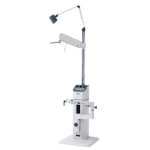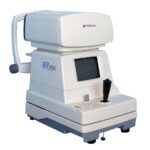Description
Bausch and Lomb Orbscan II Topographer
Orbscan II by ORBTEK (Bausch and Lomb) sets a new standard for precision measurement of the anterior segment of the eye. Utilizing a scanning slit measurement system, the instrument provides the clinician with important diagnostic information about the cornea, iris, and lens. The state of the art Orbscan II is one of the most technologically advanced corneal topography systems available.
Orbscan II provides anterior segment data in the form of topographic surfaces. Elevation topography of the anterior cornea enables clinicians to more accurately visualize the shape of abnormal corneas, which leads to more accurate diagnoses and more consistent surgical results. The reason for this is simple but important. When presented with maps of curvature or slope, you must mentally translate these data into elevation, because we visualize shape as topography (hills and valleys). This translation can be very difficult, often counter-intuitive, if the curvature map is of an asymmetric or irregular surface. Curvature alone does not usually provide sufficient useful information for the mind to construct an accurate three-dimensional shape.
Traditionally, power maps (actually surface curvature) have been axis-centered, which are method dependent and only show one selected piece of the complete angle-dependent power. The new mean and toric decomposition of the complete curvature tensor, allow clinicians for the first time to see and quantify local curvature (and paraxial power) variations as well as the fundamental spherocylindrical components. Full corneal pachymetry allows surgeons to use regional blade settings, to measure the laser ablation depth from a fixed surface (the posterior cornea), and to assess the effect of the posterior surface on corneal power. Accurate knowledge of both surfaces will provide researchers with real data for corneal mechanics simulations. The point of minimum corneal thickness is a local center of axisymmetry, which for normal corneas aligns closely to the overall optical axis of the eye.




